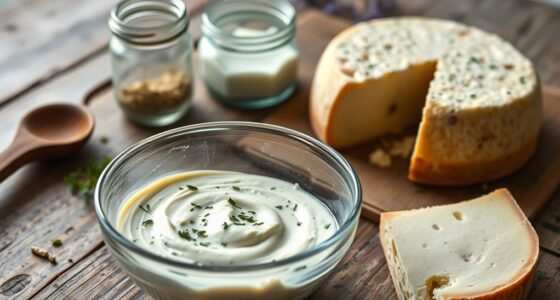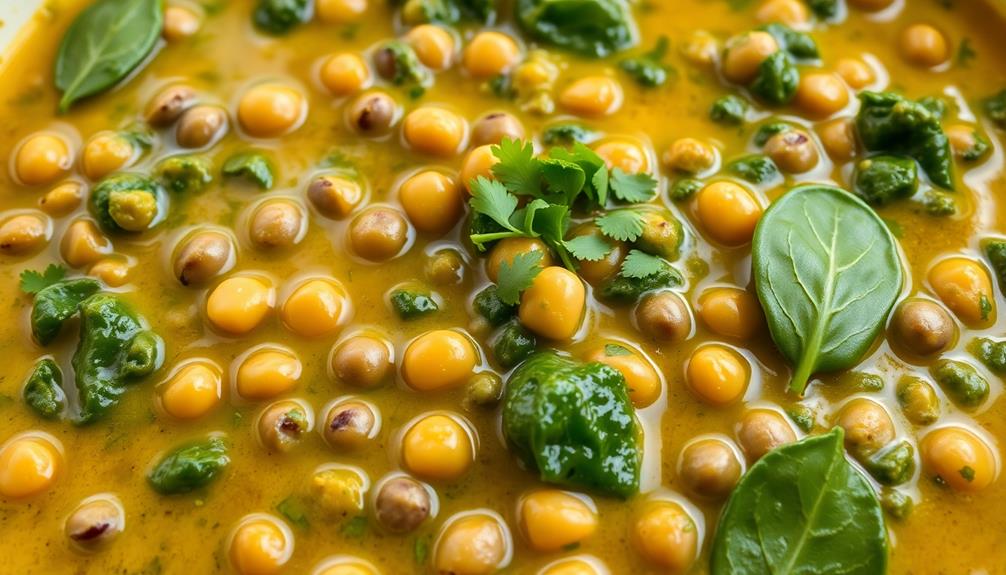Vegan aquafaba whipped cream uses plant-based proteins from chickpea liquid to create stable foam structures similar to dairy proteins in whipped cream. When whipped, these proteins form a network that traps air, giving you a light, fluffy texture that holds shape well. This process mimics the protein networks in traditional cream, making it a great dairy-free alternative. If you’re curious about how this plant protein magic works, there’s plenty more to discover ahead.
Key Takeaways
- Aquafaba’s plant proteins form a network that traps air, creating a stable, dairy-like whipped foam.
- The protein structure in aquafaba mimics egg whites, enabling quick whipping and long-lasting stability.
- Its plant-based composition offers a cholesterol-free, vegan alternative to traditional dairy whipped cream.
- Aquafaba can be combined with plant fats like coconut oil to enhance richness and texture.
- The foam maintains shape and structure, making it versatile for toppings, fillings, and decorative desserts.

If you’re looking for a dairy-free alternative to traditional whipped cream, vegan aquafaba whipped cream is an excellent choice. Made from the liquid in canned chickpeas or other legumes, aquafaba mimics the structure of egg whites, allowing you to create a light, fluffy topping that works perfectly in many culinary applications. Unlike dairy-based whipped cream, it’s entirely plant-based, making it suitable for vegans, those with lactose intolerance, or anyone seeking a healthier, sustainable option.
Vegan aquafaba whipped cream is a plant-based, dairy-free alternative perfect for light, fluffy desserts and toppings.
The magic behind aquafaba’s ability to whip into a foam comes down to its unique protein and carbohydrate structures. These plant-based proteins form a network that traps air when whipped, creating a stable foam that can hold its shape for quite some time. This structure resembles the protein networks in egg whites, which is why aquafaba can produce a similar texture. When whipped, it acts like a binder, giving volume and stability to desserts, beverages, and toppings, making it highly versatile for various culinary applications.
One of the significant advantages of using aquafaba is its ability to incorporate plant-based fats naturally present in legumes. While it’s not a source of added fats, the legumes’ inherent oils contribute to the overall mouthfeel and richness of your whipped cream. This subtle fat content enhances the cream’s body, allowing you to achieve a more satisfying texture without any dairy or animal products. You can also blend in plant-based fats, like coconut oil or vegan butter, to augment flavor and creaminess, especially if you’re aiming for a richer consistency in your recipes.
Additionally, the stability of aquafaba foam is influenced by the protein structures, which help maintain its form even after prolonged whipping or exposure to moisture. In culinary applications, vegan aquafaba whipped cream shines in more than just topping desserts. You can fold it into mousses, fillings, or even vegan ice creams, where its airy structure elevates the dish’s lightness. It’s ideal for decorating cakes, layering in parfaits, or topping fruit and hot beverages. Because it whips up quickly and holds its shape well, it’s a practical alternative for both everyday desserts and more elaborate creations. Plus, it’s free from cholesterol and saturated fats found in traditional dairy whipped creams, aligning with health-conscious choices.
Frequently Asked Questions
Can Aquafaba Be Used as a Substitute in All Whipped Cream Recipes?
You might wonder if aquafaba can replace traditional whipped cream everywhere. While aquafaba’s versatility makes it great for many whipped cream variations, it doesn’t work perfectly in all recipes. Its unique protein structure creates a different texture and stability. So, you’ll find it ideal for light, dairy-free toppings, but for some recipes, especially those needing firmer consistency, traditional cream or other alternatives might still be better.
How Does Aquafaba Compare Nutritionally to Traditional Dairy Whipped Cream?
When you compare aquafaba to traditional dairy whipped cream, you’ll find differences in nutritional content and protein levels. Aquafaba offers lower calories, fat, and protein, making it a lighter, plant-based alternative. While dairy whipped cream provides more protein, aquafaba’s nutritional profile is gentler on your diet, emphasizing hydration and minerals. So, your choice depends on whether you prioritize higher protein or a lower-calorie, vegan option.
What Are Common Flavorings or Additions for Vegan Aquafaba Whipped Cream?
You can enhance vegan aquafaba whipped cream with a variety of flavorings. Vanilla extract is a popular choice, adding a smooth, sweet aroma. Citrus zest, like lemon or lime, gives a fresh, tangy twist. You might also try cocoa powder, almond extract, or a touch of maple syrup to add sweetness. Experimenting with these additions allows you to customize your whipped cream to match your favorite desserts or beverages.
How Long Does Aquafaba Whipped Cream Stay Fresh in the Fridge?
Imagine your whipped cream sitting perfectly in the fridge, ready to elevate desserts. Typically, it stays fresh for about 24 to 48 hours, but always check storage duration and freshness indicators. Look for signs like a watery texture or off smell, which mean it’s time to toss it. Proper storage in an airtight container helps maintain its peak freshness, so you can enjoy that fluffy texture longer.
Are There Any Allergies Associated With Using Aquafaba?
You might wonder if using aquafaba causes allergic reactions. While it’s generally safe, some people with legume allergies could experience cross reactivity because aquafaba is made from chickpeas or other legumes. If you have legume allergies, it’s best to consult your doctor before trying aquafaba. Keep an eye out for symptoms like swelling or hives, and stop use immediately if you notice any adverse reactions.
Conclusion
So, next time you’re craving whipped cream but want a plant-based option, give aquafaba a try. Its unique protein structures don’t just mimic dairy; they also prove you don’t need animal products to achieve that perfect, fluffy texture. Plus, with a little experimentation, you might discover even richer flavors and stability. Don’t let skepticism hold you back—this vegan alternative can elevate your desserts with elegance and sustainability.










